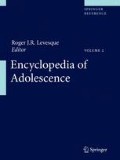Sadistic personality disorder (SDP) is characterized by an individual’s pattern of cruel, harsh, aggressive, intimidating, humiliating, and demeaning behavior. The disorder has been the subject of several studies and originally appeared in the DSM-III-R (American Psychiatric Association 1987). The disorder was included because of an effort to distinguish it from antisocial personality disorder (ASPD) or psychopathy since the constellation of traits descriptive of an individual with sadistic behavior patterns was not sufficiently explained by existing disorders (Chabrol et al. 2009). The belief that the different constellations would be useful in diagnosing individuals is what led the diagnosis to appear in the appendix of the DSM-III-R, under a section entitled, “Proposed Diagnostic Categories Requiring Further Study.” There was considerable support for including the diagnosis. A survey of forensic psychiatrists had revealed, for example, that 50% of them had, at some time, evaluated in a forensic setting a subject who exhibited behavior that met the criteria for the disorder (Spitzer et al. 1991). It was hoped that the disorder’s inclusion would stimulate further research. Eventually, however, concerns about the disorder’s validity, usefulness, and lack of supportive research led to its exclusion from other versions of more recent diagnostic manuals.
The DSM-II-R had described Sadistic Personality Disorder as beginning by early adulthood and as exhibiting a pervasive pattern of cruel, demeaning, and aggressive behavior. The manual also had noted that, to be diagnosed as a disorder, at least four repeated occurrences of a list of characteristics. Those characteristics included the use of cruelty or violence for the purpose of establishing dominance in a relationship; humiliating or demeaning people in the presence of others, unusually harsh treatment or discipline of someone under their control, being amused or taking pleasure in the psychological suffering of others, lying for the purpose of haring or inflicting pain on others, frightening others to get what they want out of them, restricting the autonomy of those with whom they have relationships, and fascination violence, weapons, martial arts, injury, or torture. Unlike antisocial or other disorders relating to violence or illegal behavior, sadistic personality disorder was distinguishable in that their actions were meant primarily to gain pleasure or achieve dominance and control, rather than primarily for profit or due to the need to cope with stressors. Sadists also were differentiated in that their violence occurred not under extreme emotional states or in the context of seeking financial gain but rather for the pursuit of pleasure, control, or satisfaction (see Myers et al. 2006). Although these differentiations may be feasible, they have yet to become officially accepted by the relevant scientific community.
Despite lack of formal acceptance of the diagnosis, research continues to examine the nature and extent of sadistic personality disorders, and that research has included adolescent samples. Results reveal high rates of sadistic personality disorder or traits in adolescent psychiatric inpatients (with rates being as high as 14% for disorders) (Myers et al. 2006) and in juvenile sexual homicide offenders (with 4 out of 14 being diagnosed as having SDP) (Myers and Monaco 2000). In non-clinical, non-forensic youth populations, reported rates of endorsement of sadistic personality disorder traits are presented as quite high. One study, for example, based on a college student sample found rates sadistic personality disorder to be 5.7% (Coolidge et al. 2001). Importantly, although these latter types of studies do not report diagnoses and they are not representative samples, they to highlight how sadistic tendencies may be considerably prevalent.
Cross-References
References
American Psychiatric Association. (1987). Diagnostic and statistical manual of mental disorders-III-revised. Washington, DC: Author.
Chabrol, H., Leeuwena, N. V., Rodgersa, R., & Séjournéa, N. (2009). Contributions of psychopathic, narcissistic, Machiavellian, and sadistic personality traits to juvenile delinquency. Personality and Individual Differences, 47, 734–739.
Coolidge, F. L., Moor, C. J., Yamazaki, T. G., Stewart, S. E., & Segal, D. L. (2001). On the relationship between Karen Horney's tripartite neurotic type theory and personality disorder features. Personality and Individual Differences, 30, 1387–1400.
Myers, W. C., Burket, R. C., & Husted, D. S. (2006). Sadistic personality disorder and comorbid mental illness in adolescent psychiatric inpatients. The Journal of the American Academy of Psychiatry and the Law, 34, 61–71.
Myers, W. C., & Monaco, L. (2000). Anger experiences, styles of anger expression, sadistic personality disorder, and psychopathy in juvenile sexual homicide offenders. Journal of Forensic Sciences, 45, 698–701.
Spitzer, R. L., Fiester, S., Gay, M., & Pfohl, B. (1991). Results of a survey of forensic psychiatrists on the validity of the sadistic personality disorder diagnosis. The American Journal of Psychiatry, 148, 875–879.
Author information
Authors and Affiliations
Corresponding author
Editor information
Editors and Affiliations
Rights and permissions
Copyright information
© 2011 Springer Science+Business Media, LLC
About this entry
Cite this entry
Levesque, R.J.R. (2011). Sadistic Personality Disorder. In: Levesque, R.J.R. (eds) Encyclopedia of Adolescence. Springer, New York, NY. https://doi.org/10.1007/978-1-4419-1695-2_594
Download citation
DOI: https://doi.org/10.1007/978-1-4419-1695-2_594
Published:
Publisher Name: Springer, New York, NY
Print ISBN: 978-1-4419-1694-5
Online ISBN: 978-1-4419-1695-2
eBook Packages: Behavioral Science

